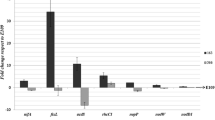Abstract
Plants of Glycine max var. Caloria, infected as 14 d old seedlings with a defined titre of Rhizobium japonicum 3Il b85 in a 10 min inoculation test, develop a sharp maximum of nitrogenase activity between 17 and 25 d after infection. This maximum (14±3 nmol C2H4 h-1 mg nodule fresh weight-1), expressed as per mg nodule or per plant is followed by a 15 d period of reduced nitrogen fixation (20–30% of peak activity). 11 d after infection the first bacteroids develop as single cells inside infection vacuoles in the plant cells, close to the cell wall and infection threads. As a cytological marker for peak multiplication of bacteroids and for peak N2-fixation a few days later the association of a special type of nodule mitochondria with amyloplasts is described. 20 d after inoculation, more than 80% of the volume of infected plant cells is occupied by infection vacuoles, mostly containing only one bacteroid. The storage of poly-β-hydroxybutyrate starts to accumulate at both ends of the bacteroids. Non infected plant cells are squeezed between infected cells (25d), with infection vacuoles containing now more than two (up to five) bacteroids per section. Bacteroid development including a membrane envelope is also observed in the intercellular space between plant cells. 35 d after infection, more than 50% of the bacteroid volume is occupied by poly-β-hydroxybutyrate. The ultrastructural differentiation is discussed in relation to some enzymatic data in bacteroids and plant cell cytoplasm during nodule development.
Similar content being viewed by others
References
Beiderbeck, R., Bopp, M.: Pflanzenkrebs durch Änderung der Erbsubstanz? Umschau 77, 698–703 (1977)
Dart, P.: Infection and development of leguminous nodules. In: A treatise on dinitrogen fixation, Section III, pp. 367–472, Hardy, R.W.F., Silver, W.S., eds. New York: J. Wiley 1977
Davey, M.R., Cocking, E.C., Bush, E.: Isolation of legume root nodule protoplasts. Nature 244, 460–461 (1973)
Dixon, R.O.D.: The structure of infection threads, bacteria, and bacteroids in pea and clover root nodules. Arch. Mikrobiol. 48, 166–178 (1964)
Dullaart, J., Duba, L.I.: Presence of gibberellin-like substances and their possible role of auxin bioproduction in root nodules and roots of Lupinus luteus. Acta Bot. Neerl. 19, 877–883 (1970)
Fawcett, D.W.: An atlas of fine structure, the cell, its organelles and inclusions. Philadelphia-London: Saunders 1966
Goodchild, D.J., Bergersen, F.J.: Electron microscopy of the infection and subsequent development of soybean root nodule cells. J. Bacteriol. 92, 204–213 (1966)
Kijne, J.W.: The fine structure of pea root nodules. I. Vacuolar changes after endocytotic host cell infection by Rhizobium japonicum. Physiol. Plant Pathol. 5, 75–79 (1975)
Klapwijk, P.M., Oudshoorn, M., Schilperoort, R.A.: Inducible permease involved in the uptake of octopine, lysopine, and octopinic acid by Agrobacterium tumefaciens strains carrying virulence-associated plasmids. J. Gen. Microbiol. 102, 1–11 (1977)
Libbenga, K.R., von Iren, F., Bogers, R.J., Schraag-Lamers, M.F.: The role of hormones and gradients in the initiation of cortex proliferation and nodule formation in Pisum sativum. Planta 114, 29–39 (1973)
Libbenga, K.R., Bogers, R.J.: Root-nodule morphogenesis. In: The biology of nitrogen fixation, pp. 430–472, Quispel, A. ed. Amsterdam-Oxford: North Holland 1974
Luft, J.H.: Improvements in epoxy resin embedding methods. J. Biophys. Biochem. Cytol. 9, 409–414 (1961)
MacKenzie, C.R., Vail, W.J., Jordan, D.C.: Ultrastructure of freeliving and nitrogen fixing forms of Rhizobium meliloti as revealed by freeze etching. J. Bacteriol. 113, 387–393 (1973)
Mosse, B.: Electron-microscope studies of nodule development in some clover species. J. Gen. Microbiol. 36, 49–66 (1964)
Newcomb, W.: A correlated light and electron microscopic study of symbiotic growth and differentiation in Pisum sativum root nodules. Can. J. Bot. 54, 2163–2186 (1976)
Postgate, J.: Consequences of the transfer of nitrogen fixing genes to new hosts. Ambio 6, 178–180 (1977)
Quispel, A.: Regulations- und Entwicklungsprobleme der symbiontischen Stickstoff-Fixierung. Ber. Dtsch. Bot. Ges. 90, 397–410 (1977)
Romanov, V.I., Jushkova, L.A., Kretovich, W.L.: Relation between the content of poly-β-oxybutiric acid in bacteroids of Rhizobium lupini and their respiration and nitrogen-fixation. Doklady Academy of Sciences of USSR 216, 694–697 (1974)
Schaede, R.: Die Knöllchen der adventiven Wasserwurzeln von Neptunia oleracea und ihrer Bakterien-Symbiose. Planta 31, 1–21 (1940)
Schlegel, H.G.: Die Isolierung von Poly-β-hydroxybuttersäure aus Wurzelknöllchen von Leguminosen. Flora 152, 236–240 (1962)
Stempak, J.F., Ward, R.T.: An improved staining method for electron microscopy. J. Cell Biol. 22, 697–701 (1964)
Stripf, R., Werner, D.: Differentiation of Rhizobium japonicum. II. Enzymatic activities in bacteroids and plant cytoplasm during the development of nodules of Glycine max. Z. Naturforsch. C, in press 1978
Syono, K., Newcomb, W., Torrey, J.G.: Cytokinin production in relation to the development of pea root nodules. Can. J. Bot. 54, 2155–2162 (1976)
Trinick, M.J.: Symbiosis between Rhizobium and the non-legume Trema aspera. Nature 244, 459–460 (1973)
Tu, J.C.: Relationship between the membrane envelopes of rhizobial bacteroids and the plasma membrane of the host cell as demonstrated by histochemical localization of adenyl cyclase. J. Bacteriol. 119, 986–991 (1974)
Tu, J.C.: Structural similarity of the membrane envelopes of rhizobial bacteroids and the host plasma membrane as revealed by freeze-fracturing. J. Bacteriol. 122, 691–694 (1975)
Werner, D., Wilcockson, J., Zimmermann, E.: Adsorption and selection of rhizobia with ion-exchange papers. Arch. Microbiol. 105, 27–32 (1975)
Werner, D.: Nitrogenase activity in the in vitro symbiosis of Rhizobium japonicum and tissue cultures of Glycine max and in Rhizobium in pure culture on defined media. Ber. Dtsch. Bot. Ges. 89, 563–574 (1976)
Werner, D., Berghäuser, K.: Discrimination of Rhizobium japonicum, Rhizobium lupini, Rhizobium leguminosarum and Rhizobium trifolii and of bacteroids by uptake of 2-ketoglutaric acid, glutamic acid and phosphate. Arch. Microbiol. 107, 257–262 (1976)
Werner, D., Stripf, R.: Differentiation of Rhizobium japonicum. I. Enzymatic comparison of nitrogenase repressed and derepressed free living cells and of bacteroids. Z. Naturforsch. C, in press (1978)
Wilcockson, J., Werner, D.: Nitrogenase activity by Klebsiella and Rhizobium on solid substrata exposed to air. Ber. Dtsch. Bot. Ges. 89, 587–607 (1976)
Author information
Authors and Affiliations
Rights and permissions
About this article
Cite this article
Werner, D., Mörschel, E. Differentiation of nodules of Glycine max . Planta 141, 169–177 (1978). https://doi.org/10.1007/BF00387885
Received:
Accepted:
Issue Date:
DOI: https://doi.org/10.1007/BF00387885




